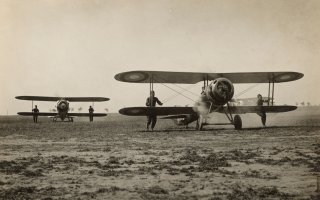Nieuport 28: A French-Built and American Flown Fighter Plane
Many of Eddie Rickenbacker’s victories were scored in the aircraft.
Here's What You Need to Know: The airplane was adopted as a stop-gap measure by the American doughboys.
When the United States military went “over there” to take on the Huns (the Germans) during the First World War, what it lacked in equipment it more than made up for in determination. However, it weapons were needed for the Americans to do the fighting.
This meant that Americans often relied on foreign equipment, and in the case of aircraft the American Expeditionary Force (AEF) used what it could get. After the French rejected the Nieuport 28C.1, which was introduced in mid-1917, in favor of the far sturdier and more advanced Spad XIII, the newly arrived Americans adopted the Nieuport 28 as a stop-gap measure.
Shortages of the Spad meant that the Nieuport 28 was issued to four American squadrons between March and August 1918, and quickly the American pilots made due with what they could. Those first American pilots who took to the skies in the lightly built aircraft soon discovered its reputation for shedding its upper wing fabric in a dive, but the pilots persevered. Soon after receiving the fighter, on April 14, 1918 American pilots Lt. Alan Winslow and Lt. Douglas Campbell of the 94th Aero Squadron each downed an enemy aircraft—the first victories by an AEF unit.
Even as the aircraft was considered practically obsolete by the time it was provided, the Americans who flew it maintained a favorable ratio of victories to losses. Many American World War I flying aces, including twenty-six-victory ace Capt. Eddie Rickenbacker, flew in the Nieuport 28 at one point in their careers, and it was only in the summer of 1918 that the aircraft was rotated out of service.
Many of Rickenbacker’s victories were scored in the aircraft, but his impressive wartime career was almost cut short when the upper wing fabric of his fighter tore apart in a flight, while Theodore Roosevelt’s son, Quentin, and fellow U.S. fighter Ace Raoul Lufbery were each killed whilst piloting a Nieuport 28.
After the war, the Nieuport 28 saw post-war service and was used by the United State Army as well as Navy, which used the aircraft in its test program to launch aircraft from the wooden decks built on the gun turrets of battleships. Following their flight mission, the aircraft either landed ashore or ditched at sea, in which case inflatable floating bags were affixed to the wings to prevent the airplane from sinking.
In addition to military use, aircraft also found civilian use, especially in Hollywood. The aircraft was used in such films as The Dawn Patrol, Ace of Aces, Men With Wings and Lafeyette Escadrille—although in most of those films the aircraft is an anachronism. The actual Lafeyette Escadrille unit, which was made up for American volunteer pilots, was operational before the Nieuport 28 entered service, although it should be noted the unit used the similar looking Nieuport 17.
Only a handful of aircraft survive, and just three original U.S.-flown Nieuport 28s are known to survive. One is in the Smithsonian’s National Air and Space Museum, while another is in the National Naval Aviation Museum in Pensacola, Florida. A restored Nieuport 28, which now carries the paint scheme of Quentin Roosevelt’s plane, is at the Museum of Flight in Seattle, Washington.
Peter Suciu is a Michigan-based writer who has contributed to more than four dozen magazines, newspapers and websites. He regularly writes about military small arms, and is the author of several books on military headgear including A Gallery of Military Headdress, which is available on Amazon.com.
This article first appeared in February 2021.
Image: Wikimedia Commons

